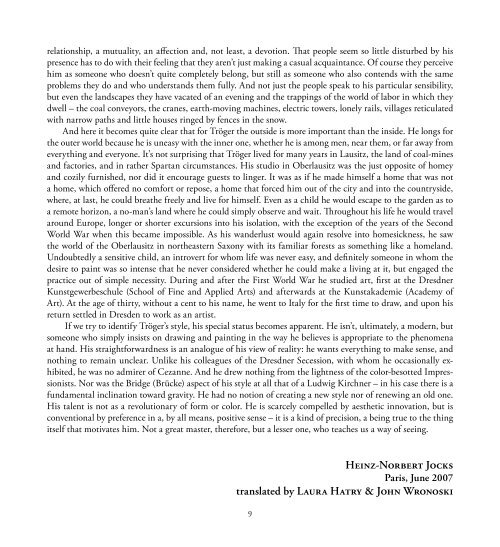Fritz Tröger - Pierre Menard Gallery
Fritz Tröger - Pierre Menard Gallery
Fritz Tröger - Pierre Menard Gallery
Create successful ePaper yourself
Turn your PDF publications into a flip-book with our unique Google optimized e-Paper software.
elationship, a mutuality, an affection and, not least, a devotion. That people seem so little disturbed by his<br />
presence has to do with their feeling that they aren’t just making a casual acquaintance. Of course they perceive<br />
him as someone who doesn’t quite completely belong, but still as someone who also contends with the same<br />
problems they do and who understands them fully. And not just the people speak to his particular sensibility,<br />
but even the landscapes they have vacated of an evening and the trappings of the world of labor in which they<br />
dwell – the coal conveyors, the cranes, earth-moving machines, electric towers, lonely rails, villages reticulated<br />
with narrow paths and little houses ringed by fences in the snow.<br />
And here it becomes quite clear that for <strong>Tröger</strong> the outside is more important than the inside. He longs for<br />
the outer world because he is uneasy with the inner one, whether he is among men, near them, or far away from<br />
everything and everyone. It’s not surprising that <strong>Tröger</strong> lived for many years in Lausitz, the land of coal-mines<br />
and factories, and in rather Spartan circumstances. His studio in Oberlausitz was the just opposite of homey<br />
and cozily furnished, nor did it encourage guests to linger. It was as if he made himself a home that was not<br />
a home, which offered no comfort or repose, a home that forced him out of the city and into the countryside,<br />
where, at last, he could breathe freely and live for himself. Even as a child he would escape to the garden as to<br />
a remote horizon, a no-man’s land where he could simply observe and wait. Throughout his life he would travel<br />
around Europe, longer or shorter excursions into his isolation, with the exception of the years of the Second<br />
World War when this became impossible. As his wanderlust would again resolve into homesickness, he saw<br />
the world of the Oberlausitz in northeastern Saxony with its familiar forests as something like a homeland.<br />
Undoubtedly a sensitive child, an introvert for whom life was never easy, and definitely someone in whom the<br />
desire to paint was so intense that he never considered whether he could make a living at it, but engaged the<br />
practice out of simple necessity. During and after the First World War he studied art, first at the Dresdner<br />
Kunstgewerbeschule (School of Fine and Applied Arts) and afterwards at the Kunstakademie (Academy of<br />
Art). At the age of thirty, without a cent to his name, he went to Italy for the first time to draw, and upon his<br />
return settled in Dresden to work as an artist.<br />
If we try to identify <strong>Tröger</strong>’s style, his special status becomes apparent. He isn’t, ultimately, a modern, but<br />
someone who simply insists on drawing and painting in the way he believes is appropriate to the phenomena<br />
at hand. His straightforwardness is an analogue of his view of reality: he wants everything to make sense, and<br />
nothing to remain unclear. Unlike his colleagues of the Dresdner Secession, with whom he occasionally exhibited,<br />
he was no admirer of Cezanne. And he drew nothing from the lightness of the color-besotted Impressionists.<br />
Nor was the Bridge (Brücke) aspect of his style at all that of a Ludwig Kirchner – in his case there is a<br />
fundamental inclination toward gravity. He had no notion of creating a new style nor of renewing an old one.<br />
His talent is not as a revolutionary of form or color. He is scarcely compelled by aesthetic innovation, but is<br />
conventional by preference in a, by all means, positive sense – it is a kind of precision, a being true to the thing<br />
itself that motivates him. Not a great master, therefore, but a lesser one, who teaches us a way of seeing.<br />
Heinz-Norbert Jocks<br />
Paris, June 2007<br />
translated by Laura Hatry & John Wronoski


